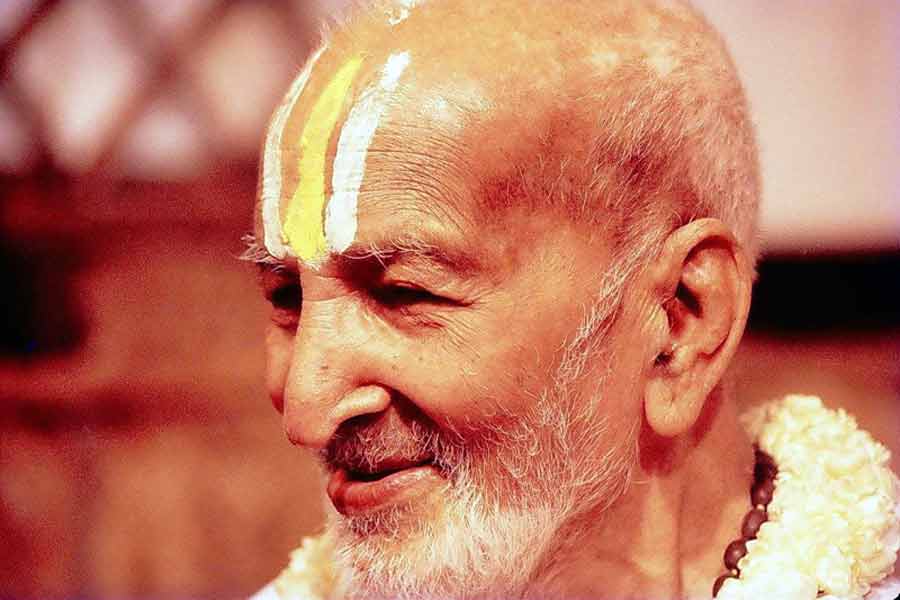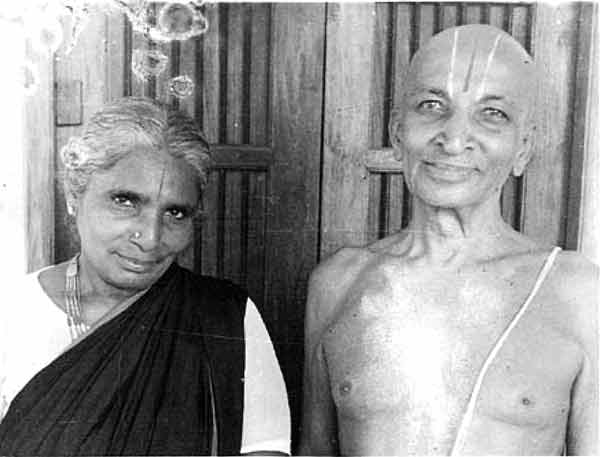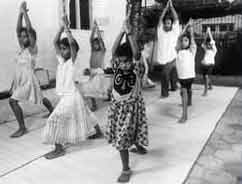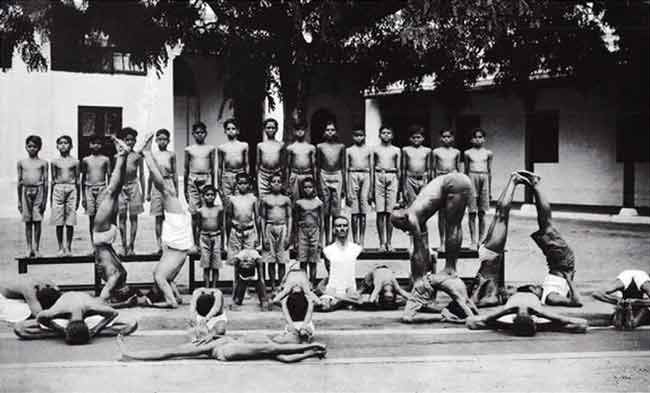
Krishnamacharya
Many students of the yoga tradition know that Sri Tirumalai Krishnamacharya (1888 - 1989) is credited with being the father of modern yoga, but most remain foggy about the details of his life and even foggier about the books he wrote.
It is understandable why his writings aren't widely known. His books have not been published in the West, and some remain untranslated. The compositions themselves are opaque. Krishnamacharya (I’ll sometimes call him “K”) was a hybrid of the old yogi and new, and often composed his treatises in the ancient style.
His language is suggestive rather than explicit, elliptical rather than direct.
Reading him takes time to understand.
Over the Christmas holidays a few years’ back, I had that time.
Years earlier, I’d ordered the Yoga Rahasya (“The Secret of Yoga”) from the publishing house of K’s son, T. K. V. Desikachar. I wanted to know all of Krishnamacharya’s written works deeply, for his personal authority carries more weight with modern yogis than any other “traditional” writer, except the trinity of the generically named Vyasa (“compiler”) credited with the c. 325 Bhagavad Gita (BG), our well-known Patanjali, author of c. 375 The Yoga Sutras (YS) and Svatmarama, author of the c. 1450 Hatha Yoga Pradipika (HYP).
The Yoga Rahasya (YR) is one of eight books by K[1].
One is an untranslated autobiography in Tamil, one is a commentary on the Yoga Sutras,[2] two are books of spiritual poetry of about 30 slokas[3] each, and four are compositions on yoga practice. The Yoga Rahasya belongs to the latter group.
K claims to have “channeled” the Yoga Rahasya at the age of sixteen when he met an incarnation of the 1200-year-old saint Nathamuni, but comments by his students; his son, Desikachar; and analyses by scholars reveal that this is a modern work.[4] K seems to offer a half-confession of this in his prelude, where he says, “I construct the essence of Yoga Rahasya to please the learned . . . I present here whatever I can recollect” (my italics).
We have records of him teaching from the Rahasya as early as 1954,[5] but he probably composed it shortly after experiencing childrearing and experimentation with postures for five or more years under the patronage of the king of Mysore.
1937 is a probable composition date. Publication happened in 1998 — nine years after his death.
As I said, K’s writing is a haphazard echo of the pre-modern yoga Classics. Leaving aside some quotes, the commentary, and the opening invocation, the Yoga Rahasya consists of 277 slokas. These are boxed in 4 chapters, reminiscent of the Yoga Sutras and the Hatha Yoga Pradipika.
Reminiscent of the Gita, chapters often change their subject abruptly and circle back to repeat what’s been talked about before—nearly word for word.
Some believe this technique is an aid to memorization. It remains a useful technique for teachers who offer these texts to their students.
Three aspects of this quasi-classic text make it novel for its era and provocative for practitioners today.
Krishnamacharya in asana practice
It names a great number of poses. Many of which are strenuously athletic, much like today’s books on yoga.
The era of the Rahasya was pivotal in Hatha Yoga’s history, and a vastly creative period for K.
Krishnamacharya belonged to a cadre of Indian physical culturists formulating a pared-down Hatha Yoga focusing on the therapeutic and athletic benefits of asana in the 1920s and 30s. The aforementioned Hatha Yoga Pradipika—the go-to Hatha text from pre-modern India—has—at most—24 poses (depending how you count). The Gheranda Samhita, a sister text from the 17th century, has—at most—39 (also, depending on how you count!).
Looking to contemporary books, Iyengar’s seminal 1966, Light on Yoga has 200-plus poses, Dharma Mittra’s simple 2002 picture book, Asanas has 608 poses. Our greatest pose compendium to date, Gharote’s 2007 Encyclopedia of Traditional Asanas, has more than 900.
K’s Rahasya has 69.
From a historical perspective, this number isn’t unheard of, but it’s enough to make us take note. Not only did the Pradipika and Gheranda have a restricted number of poses, but they devoted much of their discussion to non-asana aspects of Hatha practice. K knew he was going out on a limb by making a great number of (often complex) postures central to his method so, good scholar that he was, he sought historical “cover” for his approach.
In two blunt passages, he tells us Shiva's his advocate and his nay-sayers are ignorant:
1:48: Eminent yogis have only shown a few asana-s as examples.
In the Dhyana Bindu Upanisad, Lord Siva tells Parvati
“There are as many asana-s as
there are living species.”
1:49: Therefore, who has the authority to count the number of asana-s?
If someone says that this is the number of asana-s,
it is a reflection of his lack
of knowledge.[6]
After this, the pose descriptions begin (with many suggested variations!).
Why the dodgy debate technique? What made Krishnamacharya think he stood on slippery ground? In leaning on posture so heavily, K had few precedents to follow. We see this when we review books that had 69 or more poses before the YR.
Some contemporary people think Hatha Yoga before our day leaned primarily on poses for its method, but it didn’t.
Initiation, pranayama, internal cleansings and practices of unusual physical control received more emphasis much of the time. Of the texts existing in K’s day that gave emphasis to asana through sheer pose number, some were published books with greater or lesser circulation and some existed only in manuscript form. We’ll walk through these from most poses to least.
The c. 1840 Sri Tattvanidhi, pictured 121 poses and was both owned and produced by the Mysore potentate K worked for.[7] Around 1650, the Yogachintamani with 110 poses was composed, and the Marathi Eighty-Four Asanas of 1899 actually had 97 asanas. Many traditional texts that stick to an 84-pose list exist, and most—like Eighty-Four Asanas—are from the modern period. The main exception is the Khecarividya of Adinatha composed near 1400. Srinivasa Batta’s Hatha Ratnavali (circa 1650) looked at 84 poses, and both the 1737 Jogapradipika and c. 1850 Hastamudra Caurashi Asana of Nepal did, too.
The Eighty-Four Asanas was bookprinted, but probably had a narrow circulation. K probably didn’t see it.[8] The Tattvanidhi, Jogapradipika and Hastamudra were manuscripts. Their number and distribution were even more highly restrictive, and we can tentatively guess that even a polymath like K was ignorant of all but the Tattvanidhi.
The books of his contemporaries—which he is likely to have known about—are also absent,[9] but he probably left them unmentioned because they seemed unworthy of scholarly regard (see below).
From the list I have given, only the Tattvanidhi is listed in the bibliography of his 1934 Yoga Makaranda.[10] We’ll look a bit more closely at this bibliography below.
The Makaranda’s list was probably produced shortly before the Rahasya was composed.[11] It is possible that there are other pose-heavy books on it that informed the Rahasya, but we don’t know because many of them aren’t known to modern scholarship. Norman Sjoman said in 1996 that the Makaranda’s bibliography was a “padded [one] with works . . . that have nothing to do with the tradition he is teaching in,”[12] but in a recent interview, the Sanskritist, Christopher Tompkins, reported, “I have uncovered evidence that these six Tantras [referenced in K’s Makaranda bibliography] contained the specialized and now largely lost ‘Vinyasa-Krama’ that Krishnamacharya attempted to revive.”[13] Leaving aside the issue of vinyasa, we
might guess that a new history of pose-breadth is revealed in these books, too, but—unexpectedly—Tompkins reports that only 6 poses are described in these early sequences.[14]
It is possible other texts on the Makaranda’s bibliography are pose-heavy, or that K knew pose-rich texts he didn’t name that are unknown to today’s mainstream scholarship.
Be that as it may, with its complex inversions, arm balances, and standing poses, the Rahasya’s asanas are more athletic than any preceding classic yoga text we know of besides the Sri Tattvanidhi.[15]
Outside of classic texts, there were pose-rich texts written for popular consumption by K’s colleagues in his day, and these offer long lists of postures—some of which are also richly athletic—though less athletic than the Rahasya’s. The Rahasya probably postdates these books[16] so K could have sought “cover” from them for his pose-focus, but the YR traveled under the guise of being ancient, and acknowledging his contemporaries would have revealed this other "secret" of the Rahasya.
Like many of his colleagues, K established his skills as a malla (an athlete) in public exhibitions[17] but his pile of university degrees distinguished him as a jnani (a scholar, or one seeking the Absolute through knowing.
The Rahasya speaks to both demographics.
Consistent with K’s predilections, he probably undertook the chore of composing a modern work supported by ancient authorities to serve the need in his day for athletic, therapeutic and health-maintenance practices as readily as to make a novel declaration within yoga’s centuries-old tradition of scholastic argument.

Krishnamacharya with his wife
The Rahaysa is probably the first book to discuss yoga for women. It specifically addresses women’s needs and gives us a yoga for pregnancy.
The Rahasya is not as glamorous a Shiva Rea’s 2000 Prenatal Yoga DVD or even Geeta Iyengar’s 2010 book, Iyengar Method for Motherhood, but K supplies unique and trustworthy advice in this vein, and his focus on women is meaningful historically.
His attention to infancy and women also helps us guess as to when the text was composed.
Before he took B. K. S. Iyengar under his wing in 1934, K had taught two of Iyengar’s older sisters, Jaya[18] and Ammagiriama (who K had married in 1925).[19] He also taught yoga to his first two children, daughters, Pundarikavalli (b. 1931) and Alamelu (b. 1933).[20] His son, T. K. V. Desikachar, quoted K as saying, "I think that if we do not encourage women, the great Indian traditions will die because the men are not
following the Vedic rules and regulations. They are all becoming business people.” [21] [22]
Similarly, Rahasya, 1:14, says,
“Women, when compared to men, have a special right to practice yoga.
This is because it is women who are
responsible for the continuity of the lineage [sic].”

"The Center for Development of Women",
KYM Ramapuram, Chenai
To support this conjecture, he devotes 58 of the book’s 277 teaching slokas (21%) to reflections on women, infants and pregnancy.
K’s emphases in the Rahasya, his public statements, and his teaching activities situate him prominently within the company of Swami Vivekananda, Swami Abhedananda, Pierre Bernard, Sri Yogendra, Mollie Bagot Stack, Sita Devi Yogendra and Cajzoran Ali as the modern era’s most prominent early advocates of yoga for women.
Despite his admirable focus, if we look specifically at the YR’s material on infants, much of it is pessimistic and absurd. K uses the c. 4th century Vishnu Purana (VP) as his source and probably takes cues from similar statements in the c. 8th century BCE Garbha Upanishad.
The stylistic particulars of K’s dark view of infant life will be familiar to readers of the mukhya[23] upanishads and other old texts where the body is described as a site for worms, feces, pain, and other unpleasantries.
Citing the Vishnu Purana, K writes, “Unable to extend or contract its limbs, it (the fetus) lies tormented in a mire of excreta and urine.”[24] Other quotes from the VP attribute the infant with unbelievable philosophical reflections, e.g. “Covered by the darkness of ignorance it questions . . . by what am I bound? What is and what is not the cause? What is my action and what is not my action? What must I speak and what must I not speak?”[25]
His material on women and/or pregnancy is more practical and easier to digest.
Seventeen slokas discuss pregnancy. He recommends helpful poses and gives particular attention to pranayama for pregnancy.[26]
K had knowledge of pregnancy through his own prodigality. He had six kids! The first few he began raising in the 1930s. A man who labored in yoga’s avant garde while nurturing a new family, would naturally have reflections—in K’s case, deep reflections—on yoga’s best practices for mothers and pregnancy.
Before the Rahasya, discussions of women’s needs are almost universally absent from books on yoga. The Rahasya’s nearest timely relation is distinguished as both the first modern yoga text authored by a woman, and the first text devoted to yoga for females: Sita Devi Yogendra’s Yoga Physical Education for Women of 1934. It likely pre-dated the Rahasya by three years. Though we have ample stories of female gurus and yoginis, it goes without saying that yoga mostly belonged to the society of male sannyasins and householders before the 20th century. Both health and spiritual advice in yoga texts had been either explicitly or implicitly addressed to men.

Krishnamacharya with his students at the Yogashala in Jaganmohan Palace, Mysore, 1934
The Rahasya provides a window on the historical moment of yoga’s shift from a spiritual technology to a health technology
Though asanas had been used in the health science of Ayurveda before the 20th century, beginning in the 1920s Krishnamacharya and others[27] redirected a spiritually-focused Hatha Yoga toward the near-exclusive goals of fitness and health. To understand K’s particular Rahasya approach to this, we’ll compare the topos of modern yoga given there with that of two high-profile contemporaries.
Yogacharya Sundaram was part of an emerging movement to blend yoga with body building in the 1920s. He was known to K and had a gym and a great following in nearby Bangalore in the years K was active in Mysore. Few could match K in eloquence and textual knowledge, and Sundaram was not even in the running. With fun punctuation, strange spellings, far-out phrases, erratic syntax and odd capitalizations, he creates a mythic scene to introduce his yoga for fitness in his The Secret of Happiness or, Yogic Physical Culture [sic] from 1928:
It is a curious name, this Yoga-Asana, wonderful as its sylvan inventors,
the sages of India. . . this Yoga-asana . . . perfects the human body . . .
and prepares it for . . becoming the God-man, the Jivan-Muktha.
Whatever the object of the sages the perfection of the human body as a means to . . .
God-realisation . . . could they not utilise it as a system of
physical culture? [sic].[28]
With better writing, Swami Kuvalayananda’s 1931 Popular Yoga Asanas also juxtaposes old and new to give a modern typology.
It does so by offering a classification of yoga practice.
Yoga for health (aimed at “physiological results”) he labels “Cultural” and pre-modern yoga, (aimed at accommodating “the spiritual force called Kundalini”) is labeled as “Meditative:”
Asanas are divided into . . . Cultural and Meditative . . . In trying
to obtain physiological results by the practice of the cultural poses, both spiritual culturalists
as well as physical culturalists wish to maintain the nervous and the endocrine systems . . .
A student of spiritual culture [however] . . . undertakes the practices of the cultural poses
with a larger object in view. He wants the nervous system to be . . . trained . . .
[to] bear the interaction of the spiritual force called Kundalini . . . [29]
Krishnamacharya introduces a new yoga-for-the-body a different way.
While Sundaram speaks as an athlete and Kuvalayananda, who did laboratory work on yoga[30], speaks as a scientist, Krishnamacharya speaks as an athlete, a devotee and a scholar. Like Kuvalayananda, he creates a classification system, but his styles of practice are attuned to the practitioner’s age.
In the quote below, K’s Brahmachari refers to the state of youth, his Grhastha refers to adulthood, and Sanyasi, refers to old age:[31]
Yoga . . . can be divided into three types of practice.
Understanding that Srsti Krama [Releasing Practice] is for the Brahmachari [student],
Sthiti Krama [Strength or Health Practice] for the Grhastha [householder]
and Samhara Krama [Withdrawing Practice] for the Sanyasi [renunciant],
yoga must be accordingly practiced.[32]
Elsewhere, he gives us two outcomes for these practice types, but only one is “approved by the scriptures:”
The fruits of yoga . . . can be material (bhukti) or freedom from suffering (mukti).
Those who are devotees of the Lord, praise Hari [the sustainer god, Vishnu] for the purpose of mukti.
Others seek material benefit, which is not approved by the Sastra-s
[scriptures].[33]
In other words, no matter what kind of yoga you are doing in whatever stage of life, if you adore the Highest while practicing, your benefit will be mukti (liberation), but if you forget the Lord in practice, your benefits will be only material (like Kuvalayananda’s “Cultural” yoga). You will miss the boat.
He wants you to keep Hari in mind, so that whether you are a youth doing yoga for athletics, or an adult doing yoga for health maintenance, you’ll still share in the aim of oldsters who do yoga for liberation.
K unifies the categories of modern practice by featurizing them with the bhakti yoga of devotion (first firmly articulated in the Bhagavad Gita) and thence directing them toward the Highest. Consistent with his promotion of the householder path throughout his career, K explains that you can adjust yoga to whatever stage of life you find yourself in and still get the fruit of an ultimate sadhana (spiritual method).
In these passages, the Rahasya speaks as the Gita does in several ways. It delimits the many yogas it describes by saying bhakti yoga is best, guarantees liberation through this method, and is particularly attuned to the life of the householder. Hence, the shift to a body-focused yoga that K both articulates and justifies in the Rahasya is only partial. Unlike Sundaram and Kuvalayananda, Krishnamacharya’s yoga of health did not cut the practice off yoga’s most advanced goals.
Conclusions
Throughout K’s “Secret of Yoga” he foreshadows today’s practice while remaining faithful to yoga’s traditional aim of liberation. There is a
breadth, freshness and faithfulness to the received tradition in K’s writing. These make the Rahasya a compelling patchwork of old and new, and a
special window into Krishnamacharya’s thoughts in the period he wrote.
The Rahasya is “secret” (rahasya) like a seed; the progeny of a great yogi, it contains yoga’s soon-to-be-prominent concerns in embryonic
form. It contributes to our modern emphasis on athleticism, posture, and yoga for women. Speaking the language of the past, it addresses the pressing
concerns of our living practice.
Appendix
The poses of the Yoga Rahasya (by chapter and verse)
1. Astavakrasana, 1.50-51
2. Bherundasana, 2.18
3. Bhekasana, 2.19
4. Baddha Konasana, 1.73, 2.13, 3.23
5. Baddha Padmasana, 2.13
6. Bakasana, 2.19
7. Bhadrasana, 1.73
8. Bharadvajasana, 2.16, 3.10
9. Bhujangasana, 2.14
10. Brahmasana, 1.73
11. Cakorasana, 2.14
12. Catuspadapitham, 2.14
13. Dandasana 1.53-54, 1.74, 2.13, 3.10
14. Dhanurasana, 2.17
15. Dvipdapitham, 3.19
16. Ganda Bherundasana, 2.18
17. Garbhapindasana, 2.15
18. Garudasana, 2.16
19. Gomukhasana, 2.16
20. Kapotasana, 2.21
21. Konasana, 2.20
22. Halasana, 2.17
23. Jathara Parivrtti, 1.52, 2.17
24. Kaundinyasana, 1.50-51
25. Krauncasana, 1.50-51, 1.74, 2.14
26. Kukkutasana, 2.15
27. Kurmasana, 2.15
28. Mahamudra, 2.13, 3.23
29. Makrasana, 2.19
30. Maricyasana, 1.50-51, 2.17
31. Matsyasana, 2.17, 2.19
32. Matsyendrasana, 2.19
33. Mayurasana, 2.15
34. Mulabhandasana, 1.73
35. Natarajasana, 1.50-51, 2.18
36. Parvatasana, 2.22
37. Pascimatanasana, 2.13
38. Padmasana, 1.73, 2.15, 3.10, 3.20
39. Pincha Mayurasana, 2.15
40. Purvatansana, 2.14
41. Salabhasana, 2.14, 2.18
Sarvangasana, 3.11, 1.53-54
42. Setubhandasana, 1.50-51
43. Siddhasana, 1.73, 2.24
44. Simhasana, 2.16
45. Sirsasana, 3.11, 1.53-54, 2.13
46. Sirsa Dandasana, 2.18
47. Svastikasana, 1.73, 2.24
48. Supta padangusthasana, 1.50-51
49. Supta Prasarita Padangusthasana, 1.50-51
50. Tadakamudra, 2.13
51. Tadasana, 3.23
52. Trikoasana, 1.50-51
53. Trivikramasana, 2.16
54. Unmukha pitham, 3.18
55. Urdhvakukkutasana, 1.50-51, 2.17
56. Ustrasana, 2.21
57. Uttana Kurmasana, 2.16
58. Uttana Mayurasana, 1.50-51
59. Uttanapadasana, 1.50-51
60. Uttanasana, 3.23
61. Uttanashiki (Uttana Mayurasana), 2.23
62. Vajrasana, 1.73, 2.14, 3.10
63. Vasisthasana, 1.50-51, 2.17
64. Vatayanasana, 2.16
65. Viparita Dandasana, 1.53-54
66. Virabhadrasana, 1.50-51
67. Virasana, 1.74, 3.10
68. Vrscikasana, 2.14, 2.19
69. Yoga Nrsimhasana, 2.15
The pranayamas of the Yoga Rahasya
1. Andoli, 1.100
2. Bhramari, 1.100
3. Bhastrika, 1.100-101, 3.14
4. Kapalabhati, 1.100-101, 3.14
5. Lahari, 1.100
6. Nadi Shodana, 1.100, 1.103, 2.61, 3.16
7. Sama Vrtti, 1.94
8. Sitkari, 1.100
9. Surya Bhedana, 1.100, 2.61, 3.16
10. Sithali, 1.100, 2.61, 3.16
11. Ujjayi, 1.33, 1.100, 2.61
The bhandas of the Yoga Rahasya
Jalamdhara, 1.60, 1.71-78, 1.80-1.83 1.101, 2.50, 2.52, 3.15
Mulabhanda, 1.60, 1.62, 2.50-51, 3.14
Uddiyana, 1.60, 1.64-70, 2.50, 2.52, 3.14
The vayus of the Yoga Rahasya
Apana Vayu, 3.15